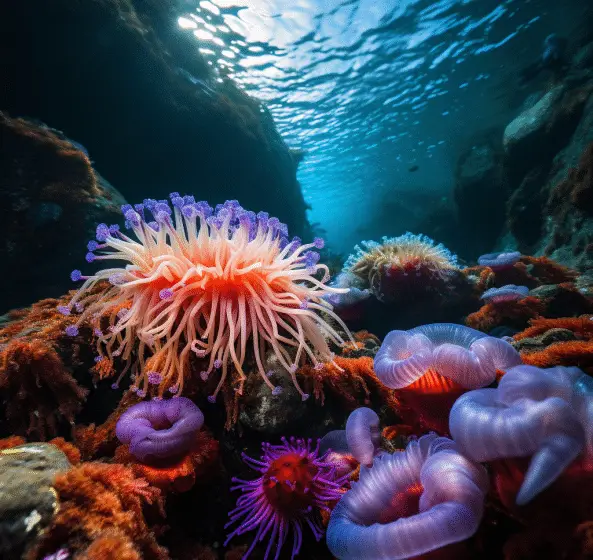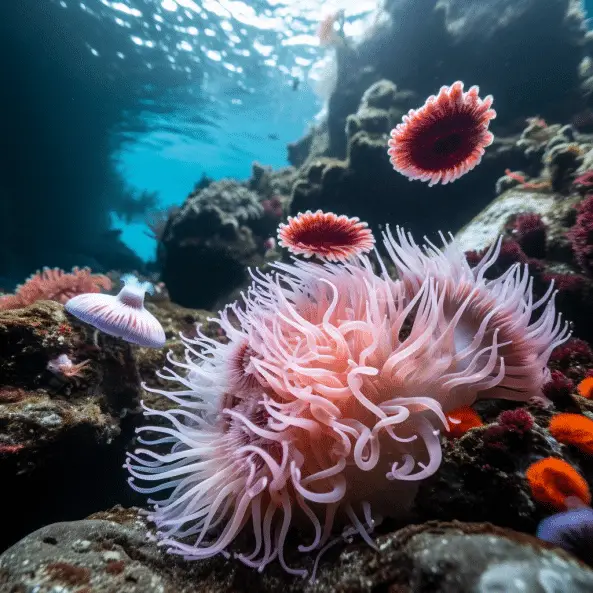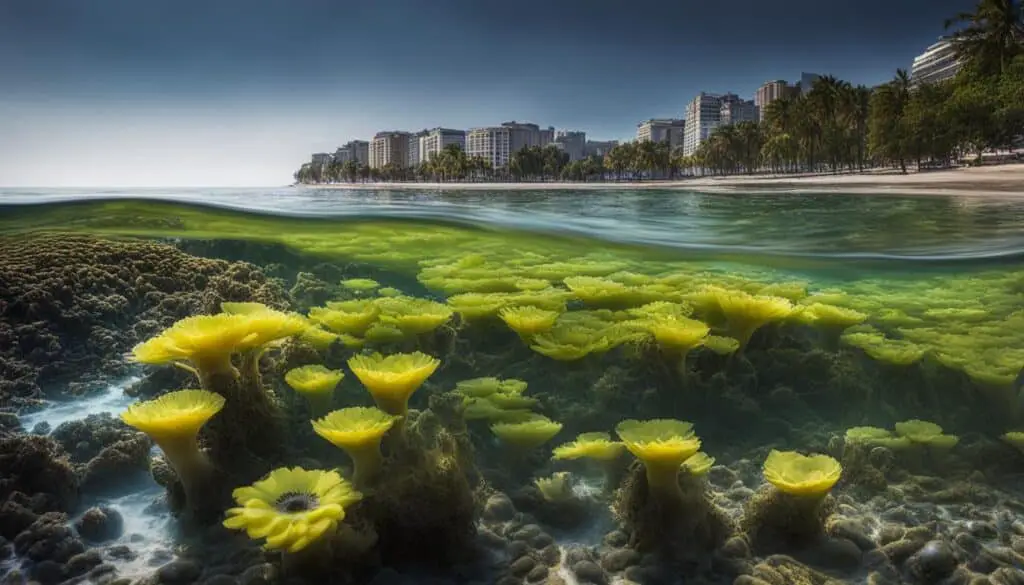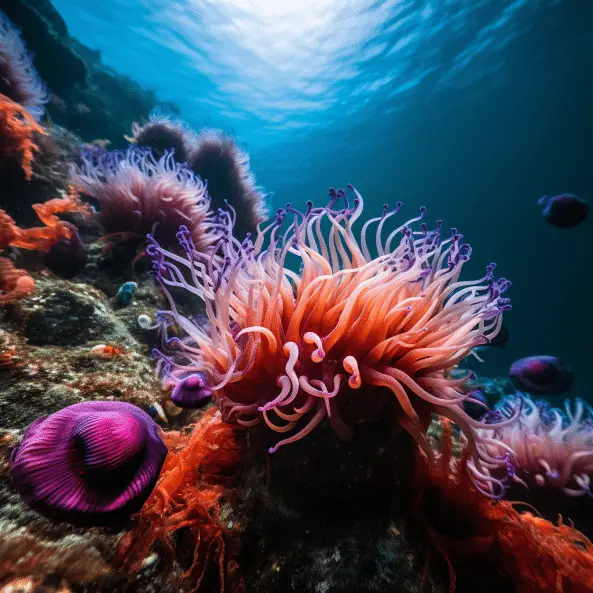Unveiling the Impact: Sea Anemones and Climate Change

Climate-Change-and-Sea-Anemone-Conservation: Climate change is an undeniable threat that affects various ecosystems and species around the world. Coastal organisms, including sea anemones, are particularly vulnerable to the changing environmental conditions brought about by global warming. As ocean temperatures continue to rise, sea anemones face numerous challenges in adapting to these changes.
Anemones, like other marine animals, vary in their susceptibility to rising temperatures seasonally, according to research. They are physiologically adapted to summer and winter temperatures. Thus, elevated seawater temperatures may affect their performance differently depending on the season.
Due to their wider thermal tolerance, rising ocean temperatures may benefit non-native sea anemone species over native ones. This can worsen coastal ecosystem balance.
Predicting and managing environmental changes on sea anemones requires understanding climate change.

Key Takeaways:
- Sea anemones are facing challenges in adapting to the changing conditions brought about by climate change.
- They exhibit seasonal variation in their tolerance to higher temperatures.
- Non-native species with wider thermal tolerance ranges may be favored over native species as ocean temperatures rise.
- Understanding the impact of climate change on sea anemones is crucial for their conservation.
- Efforts should be made to predict and mitigate the effects of climate change on sea anemones and coastal ecosystems.
Thermal Tolerance and Seasonal Acclimation of Sea Anemones
Heat tolerance and seasonal adaptation make sea anemones versatile. Survival and reproduction depend on seasonal temperature tolerance. Temperate sea anemones have adapted physiologically to endure summer and winter.
Seasonal temperature affects sea anemone behavior, mobility, and reproduction. Some sea anemones reproduce asexually in winter. However, climate change-induced temperature increases can disrupt this reproductive cycle, lowering population numbers and perhaps threatening their survival.
Rising sea levels and temperatures harm intertidal and shallow coastal sea anemones. These ecosystems may collapse, threatening sea anemones. Thus, conservation measures must include their temperature tolerance and how rising sea levels may affect their habitat.
Preserving Sea Anemones in a Changing Climate
To safeguard sea anemones in the face of climate change, it is essential to understand their thermal tolerance and develop effective conservation measures. Researchers and conservationists can work together to monitor sea anemone populations and identify areas at higher risk due to ocean warming and rising sea levels. By implementing measures to protect these vulnerable habitats, such as establishing marine protected areas or reducing pollution, we can help preserve the delicate balance of coastal ecosystems that sea anemones rely on for survival.
Furthermore, educating the public about the importance of sea anemones and their role in marine ecosystems can garner support for conservation efforts. By raising awareness about the threats posed by climate change and advocating for sustainable practices, we can contribute to the long-term preservation of sea anemones and the biodiversity of our oceans.

Table: Comparing Threats to Sea Anemones
| Threat | Impact |
|---|---|
| Rising ocean temperatures | Disrupts reproductive cycles, decreases population numbers |
| Rising sea levels | Loss of suitable habitat, submerges intertidal zones |
| Pollution | Degrades water quality, affects feeding and growth |
| Habitat destruction | Removal of substrate and hiding places, reduces shelter |

Conclusion
Sea anemones possess remarkable adaptive capabilities, enabling them to withstand fluctuating temperatures and survive in a range of habitats. However, climate change presents significant challenges to their thermal tolerance and overall survival. By understanding their physiological responses to changing conditions and implementing effective conservation strategies, we can strive to preserve these unique creatures and the diverse marine ecosystems they inhabit.
Recent research has shed light on the remarkable potential of epigenetic mechanisms in sea anemones to aid in their adaptation to environmental stress, including the challenges posed by climate change. Epigenetic modifications, such as DNA methylation, play a crucial role in influencing gene expression without altering the genetic sequence itself. These modifications allow sea anemones to respond and acclimate to extreme conditions, such as rising sea temperatures.
Scientists have focused their studies on understanding how sea anemones utilize epigenetic mechanisms to regulate gene expression involved in their symbiotic relationship with photosynthetic algae. By unraveling the genes responsible for the establishment, maintenance, and breakdown of this symbiosis, researchers have opened up exciting possibilities for harnessing epigenetics to bolster the thermal resilience of not just sea anemones, but also corals.
One potential avenue is the application of selective breeding or manipulation of gene expression. By “training” sea anemones with improved thermal resilience in specialized nurseries, it may be possible to enhance their chances of survival in the face of climate change. This targeted approach could have far-reaching implications, bolstering the health and resilience of coral reef ecosystems in the long run.
Ultimately, the exploration of epigenetic mechanisms in sea anemones offers a ray of hope amidst the challenges presented by climate change. By tapping into their genetic adaptability and utilizing the power of epigenetics, we have the potential to protect these stunning marine organisms and the delicate ecosystems they call home.
FAQ
What are the impacts of climate change on sea anemones?
Climate change poses significant challenges to the adaptation and survival of sea anemones. Rising ocean temperatures and the associated changes in environmental conditions can affect their performance and reproductive capacity, while rising sea levels can threaten their habitats.
How do sea anemones cope with changing temperatures?
Sea anemones exhibit thermal tolerance and seasonal acclimation to cope with changing temperatures. They are adapted to higher temperatures in the summer and lower temperatures in the winter. However, increases in temperature can compromise their reproductive processes, affecting population persistence.
Are non-native species of sea anemones more resilient to climate change?
Non-native species of sea anemones, which often have a wider thermal tolerance range, may be favored over native species as ocean temperatures continue to rise. This can impact the balance of marine ecosystems and the survival of native species.
Can epigenetic mechanisms help sea anemones adapt to climate change?
Recent research has shown that sea anemones can use epigenetic mechanisms, such as DNA methylation, to optimize their gene expression and acclimate to environmental stress, including climate change. Understanding these mechanisms opens up possibilities for improving the thermal resilience of sea anemones and coral reef ecosystems.



